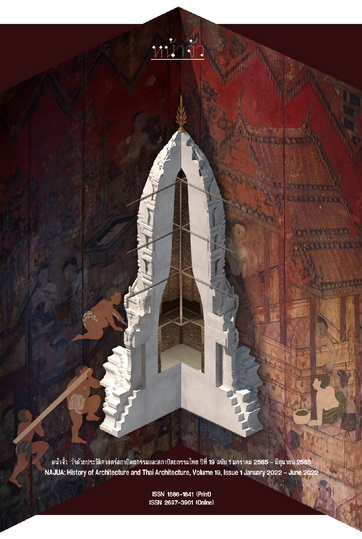The Appropriate Outdoor Environment for Age-Friendly Urban Community in Bangkok Metropolis
Main Article Content
Abstract
The objective is to establish the appropriate outdoor environment with an age-friendly urban community approach. Survey research was conducted through the survey of 6 communities, the investigation of existing outdoor environment conditions, and the interview of the ageing and community leader. The results of the four characteristics investigation: outdoor physical condition, accessibility, multipurpose building, and community facilitates, showed that all of the study areas are not appropriate for ageing. The community facilities and the accessibility showed mean scores lower by the criteria of appropriate physical characteristics. The interview results also indicated that most of the ageing prefer outdoor areas where provide safety, shade and seating. Health and social activities are the supportive factors of outdoor activities. Limitation in the development of outdoor space is budget.
Downloads
Article Details

This work is licensed under a Creative Commons Attribution-NonCommercial-NoDerivatives 4.0 International License.
References
Aspinall, Peter A., and others. “Preference and relative importance for environmental attributes of neighbourhood open space in older people.” Environment and Planning B: Urban Analytics and City Science 37, 6 (2010): 1022-1039. Accessed May 29, 2022. Available from https://doi.org/10.1068/b36024
Calkins, Margaret P. Design for dementia: Planning environments for the elderly and the confused. Maryland: National Health Pub, 1988.
Foundation of Thai Gerontology Research and Development Institute (TGRI). rāingān pračham pī sathānakān phūsūngʻāyu Thai Phō̜.Sō̜. sō̜ngphanhārō̜ihāsipsām [Situation of the Thai elderly 2010]. Bangkok: Foundation of Thai Gerontology Research and Development Institute, 2012. Accessed May 29, 2022. Available from https://www.dop.go.th/download/knowledge/knowledge_th_20160106141440_1.pdf
Francis, Jacinta, and others. “Quality or quantity? Exploring the relationship between public open space attributes and mental health in Perth, Western Australia.” Social Science & Medicine 74, 10 (May 2012): 1570-1077. Accessed May 29, 2022. Available from https://doi.org/https://doi.org/10.1016/j.socscimed.2012.01.032
Gehl, Jan. Life between buildings: Using public space. Washington, DC: Island Press, 2011.
“kot krasūng kamnot sing ʻamnūai khwām sadūak nai ʻākhān samrap phū phikān rư̄ thupphonlaphāp læ khon charā chabap thī sō̜ng [Ministerial regulations to prescribe provision of facilities in the buildings for the disabled or handicapped and old people, No.2].” Thai Government Gazette, volume 138, part 6 Ko (March 4, 2021): 19-29.
Levy-Storms, Lene, Lin Chen, and Anastasia Loukaitou-Sideris. “Older adults’ needs and preferences for open space and physical activity in and near parks: A systematic review.” Journal of Aging and Physical Activity 26, 4 (2018): 682-696. Accessed May 29, 2022. Available from https://doi.org/10.1123/japa.2016-0354
Loukaitou-Sideris, Anastasia, and others. “Parks for an aging population: Needs and preferences of low-income seniors in Los Angeles.” Journal of the American Planning Association 82, 3 (2016): 1-16. Accessed June 8, 2020. Available from https://doi.org/10.1080/01944363.2016.1163238
Lui Chi-Wai, and others. “What makes a community age-friendly: A review of international literature.” Australasian Journal on Ageing 28, 3 (August 2009): 116-121. Accessed May 29, 2022. Available from https://doi.org/https://doi.org/10.1111/j.1741-6612.2009.00355.x
Pawit Srilamul. “nǣothāng kānkamnot phư̄nthī læ sing ʻamnūai khwām sadūak samrap phūsūngʻāyu nai sūan sāthārana radap chumchon phư̄a chai pen khō̜ phičhāranā nai kānʻō̜kbǣp [Guidelines for area designation and facilities as design criteria for elders in community public parks].” Master Thesis, Chulalongkorn University, 2009.
Sariyamon Tiraphat, and others. “The role of age-friendly environments on quality of life among Thai older adults.” International Journal of Environmental Research and Public Health 14, 3 (2017). Accessed May 29, 2022. Available from https://doi.org/10.3390/ijerph14030282
The Bureau of Registration Administration (ฺBORA). khō̜mūn čhāk rabop sathiti thāngkān longthabīan krommakān pokkhrō̜ng pī Phō̜.Sō̜. sō̜ngphanhārō̜ihāsipkāo [Department of provincial administration: Official statistics registration systems data 2010]. Accessed May 29, 2022. Available from https://stat.bora.dopa.go.th/new_stat/webPage/statByProvince.php?year=59
Thompson, Catharine Ward. “Activity, exercise and the planning and design of outdoor Spaces.” Journal of Environmental Psychology 34 (June): 79-96. Accessed May 29, 2022. Available from https://doi.org/https://doi.org/10.1016/j.jenvp.2013.01.003
United Nations. “Policies on spatial distribution and urbanization have broad impacts on sustainable development.” Population Facts, No.2020/2 (December 2020): 1. Accessed May 25, 2022. Available from https://www.un.org/development/desa/pd/sites/www.un.org.development.desa.pd/files/undes_pd_2020_popfacts_urbanization_policies.pdf
World Health Organization. Age friendly environment. Accessed June 8, 2020. Available from https://www.who.int/teams/social-determinants-of-health/demographic-change-and-healthyageing/age-friendly-environments
World Health Organization. Global age-friendly cities: A guide. Geneva: World Health Organization, 2007.
Yang Zhai, Li Kankan, and Liu Jianjun. “A conceptual guideline to agefriendly outdoor space development in China: How do Chinese seniors use the urban comprehensive park? A focus on time, place, and activities.” Sustainability 10, 10 (2018): 3678. Accessed May 29, 2022. Available from https://doi.org/10.3390/su10103678
Yung Esther H.K., Ho Winky K.O., and Chan Edwin H.W. “Elderly satisfaction with planning and design of public parks in high density old districts: An ordered logit model.” Landscape and Urban Planning 165 (September 2017): 39-53. Accessed June 8, 2020. Available from https://doi.org/https://doi.org/10.1016/j.landurbplan.2017.05.006


